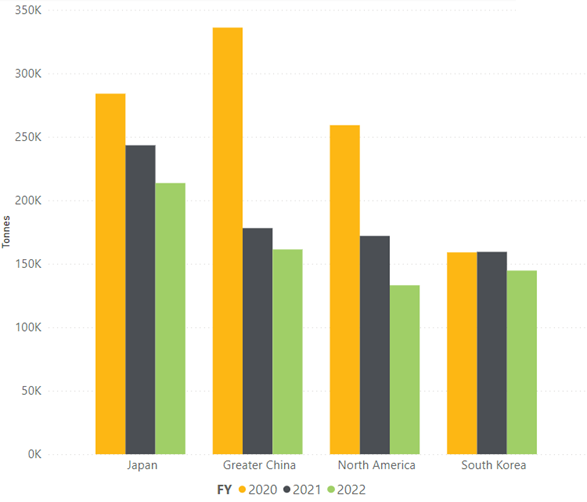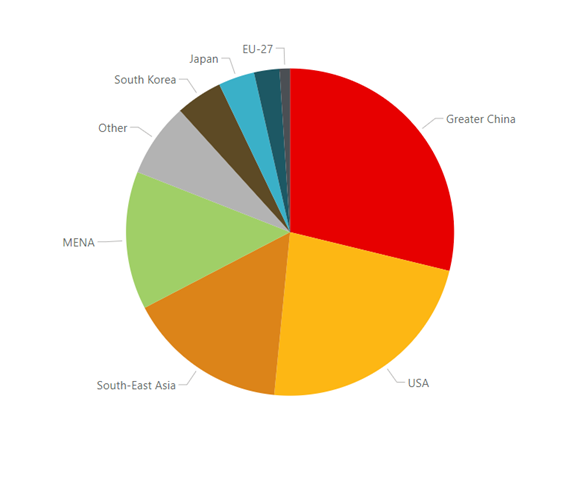Key points:
- Overall red meat exports in 2021–22 fell by 11% year-on-year.
- Sheepmeat exports to the US grew by 5%, demonstrating growing demand from American consumers for Australian sheepmeat.
- Overall goatmeat exports grew by 24% year-on-year, with the US dominating overall export volumes.
With the 2021–22 financial year in the rear-view mirror, we’re starting to see emerging trends in red meat exports that bode well for the industry. As the herd and flock rebuilds begin to mature, exports are rising despite ongoing challenges from an unsettled global landscape.
Australia exported 1.3 million tonnes of red meat in FY2022, 11% lower than FY2021. This drop was broadly consistent across our major markets – exports to Japan fell by 11%, China by 13%, South Korea by 9% and the US by 13%. This was primarily driven by falls in beef; FY2022 beef exports were 13% lower than FY2021, at 786,688 tonnes.
Figure 1: Beef exports to top four markets
Grainfed vs grassfed beef exports
Grainfed exports held up more strongly, falling by only 5% to 282,979 tonnes, while grassfed beef exports fell by 17% to 503,709 tonnes. Moreover, grainfed beef made up 36% of exports over the financial year, up 3% from FY2021 and a new record high. The emergence of grainfed beef as a mainstay of Australian exports has helped to ensure supply to key markets, even in an environment with relatively limited production.
Beef exports to the US were especially soft, falling by 24% to 123,426 tonnes. American production has been at near record highs for the past year, as drought conditions in the south and southwest of the country cause a huge destocking event.
Sheepmeat
Exports of lamb fell by 7% to 245,772 tonnes, while mutton exports fell by 2% to 129,076 tonnes. Exports to China fell by 18% for lamb and 21% for mutton, to 49,383 tonnes and 48,581 tonnes respectively. Despite this, China remained our largest export market for sheepmeat, importing 97,639 tonnes overall.

Figure 2 Sheepmeat exports by destination
Sheepmeat exports to the USA grew by 5%; lamb exports rose by 2% to 67,104 tonnes and mutton exports grew by 19% to 17,580 tonnes. This rise in volume, alongside high prices paid by American importers, made the US the most valuable market in FY2022, despite lower volumes than China.
Sheepmeat exports were strong in South-East Asia, and relatively weaker in the Middle East and North Africa (MENA) region. Lamb exports rose by 20% in South-East Asia, as increased demand from Papua New Guinea and Malaysia offset smaller drops in other parts of the region – while lamb exports to MENA fell by 26%, as the end of subsidies for Australian lamb from Qatar caused a large drop in volume from what was Australia’s third-largest lamb market. Mutton exports to South-East Asia stayed flat, while they grew by 24% in MENA to 17,525 tonnes, partially offsetting the decline in lamb exports.
Goatmeat
Goat exports had a remarkable year, growing by 24% to 19,474 tonnes. The US remained the largest market, receiving 64% of export volume, while South Korea saw the largest market growth, with exports rising by 51% to 2,503 tonnes.
Exports have long been expected to rise over 2022. Supply chain issues, extreme weather events along the east coast and labour shortages delayed that uplift, as processors were unable to operate at full capacity and exporters struggled to send exports to market.
Despite this, there’s a positive trend beginning to develop; after a rough start to the year, exports in May and June have been up 3% year-on-year, with beef exports growing by 5% in May and 8% in June.
This means the industry goes into the new financial year in a strong position. Prices remain at elevated levels globally, and production from the United States is projected to fall over the next two years – giving us a strong position in Japan and Korea, two markets where we compete with the US for market share.
Attribute above content to:
Tim Jackson, MLA Business Analyst






